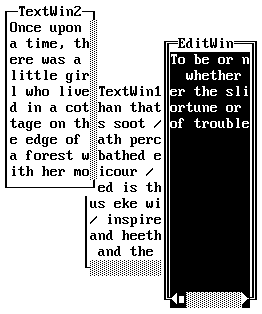
No matter what design technique you employ, you must define what the program is supposed to do before you can begin designing. Consider how the completed program should behave.
The windowing package does not form a stand-alone application. It is meant to be used by a client who is writing a stand-alone program that displays text in multiple, overlapping windows. The windows can scroll in both vertical and horizontal directions, so a window can contain more text than it can display at once. The windows can be manipulated with either the keyboard or the mouse. For example, the user can scroll a window by moving its cursor with the keyboard cursor keys or by clicking on its scroll bar(s) with the mouse. It's possible to create windows in which the user can enter text or execute commands. (Note that the user is not necessarily the client; the user is the person who uses the program that the client has written.)

Because a user can interact with only one window at a time, whether scrolling or entering text, you need a way to specify which window receives input. That window is the active window. Only one window can be active at any given time.
The active window must be fully displayed. It cannot have any portion obscured by other windows. Whenever an inactive window becomes active, it must be redisplayed over any windows that might cover it (like a sheet of paper being moved to the top of a stack of paper). The user changes the active window by clicking the mouse on an inactive window or by entering a keyboard command.
The program is illustrated in Figure 10.1.